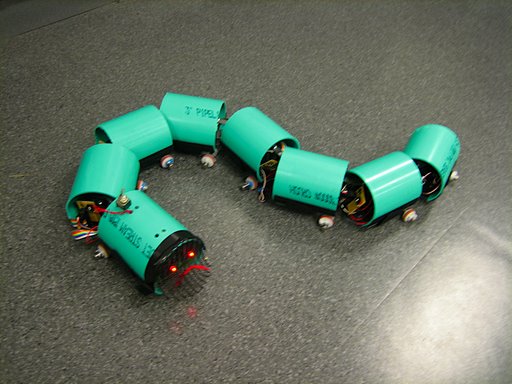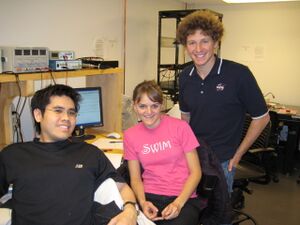Difference between revisions of "Robot Snake"
ClaraSmart (talk | contribs) |
ClaraSmart (talk | contribs) |
||
| Line 94: | Line 94: | ||
Needs description of servo - include discussion of how we aligned them (through code) |
Needs description of servo - include discussion of how we aligned them (through code) |
||
Needs discussion on batteries. Rechargeable vs Alkaline, 4 vs 5 etc. |
|||
Needs circuit diagram for servo boards and/or picture |
Needs circuit diagram for servo boards and/or picture |
||
Revision as of 22:42, 15 March 2008
Overview
Team Members
- Michael Hwang - Electrical Engineer - Class 2008
- Andrew Long - Mechanical Engineer - Class 2009
- Clara Smart - Electrical Engineer - Class 2009
Snake Motion

Snakes are able to adapt their movement to various environments. For instance, snakes can move across extreme environments such as sand, mud and water. Research has discovered there are four types of snake motion, as shown in the image. These motions include; serpentine movement, rectilinear movement, concertina movement and side-winding movement.<ref>Ma, Shugen. "Analysis of creeping locomotion of a snake-like robot." Advanced Robotics Vol.15, No.2 (2001): 205</ref> The most common motion exhibited by most snakes is serpentine motion where section follows a similar path. In order for snakes to successfully locomote using serpentine motion, the belly of the snake must have anisotropic coefficient of friction for the normal and tangential directions. Specifically, the normal friction must be greater than the tangential friction. As a result, when the snake exhibits a force on the ground, it will move in the tangential direction without slipping in the normal direction.<ref>Saito, Fukaya, Iwasaki. "Serpentine Locomotion with Robotic Snakes". IEEE Control Systems Magazine (Feb 2002): 66.<ref/>
Advantages / Disadvantages of Robotic Snake Motion
Advantages
Many robots are limited by the use of motorized wheels. However, there are many advantages for building a robot that mimics the motion of a snake. Several advantages for movement of snake robot are listed below:
- Move across uneven terrain since it is not dependent on wheels
- Possibly swim if water-proofed
- Move across soft ground such as sand since it can distribute its weight across wider area
Also, from a systems standpoint, the snake robot can be very modular with many redundant segments. As a result, it is very easy to replace broken segments as well as shorten or lengthen the robot.
Disadvantages
Although there are many advantages for building a snake like robot, there are several disadvantages which are listed below:
- Low power and movement efficiency
- High cost of actuators (servos or motors)
- Difficult to control high number of degrees of freedom
Cite = Page 206
Robot Snake Motion
Real snake motion does not follow specified equations. However, research has proven that the serpentine motion of a snake can be modeled with the following equations:
where the parameters a, b, and c determine the shape of the serpentine motion. The graph shows how the parameters influence the serpentine curve. Basically, a changes the appearance of the curve, b changes the number of phases, and c changes the direction.
The serpentine curve can be modeled with a snake like robot by changing the relative angles between the snake robot segments using the following formula with the number of segments (n):
where α , β , and γ are parameters used to characterize the serpentine curve and are dependent on a, b, and c as shown below:
The equations above for φi,α,β, and γ were used in this snake like robot as shown in the code section.
Mechanical Design
The robotic snake consists of a head segment, which houses the onboard electronics, including the xBee radio, and independently controlled body segments, which house servo motors and the batteries required to power each motor. As the snake is designed to be modular, there is no limit to the number of body segments. More segments will allow it to move more smoothly, while fewer segments will be easier to control. For this design, seven body segments were used do to material limitations.
Mechanically, the snake is designed to move in a serpentine motion, imitating the motion of a real snake. As discussed above, real snakes move with anisotropic coefficients of friction. It is difficult to locate materials with this property, but passive wheels satisfy the requirements for differences in friction. The friction will be lower in the direction of rolling, thus providing the required difference in friction. The only problem with this approach is that the wheel may slide in the normal direction if the weight applied to the wheel is not sufficient.
Needs Description of Chassis + Picture + Template
Needs Description of wheels (pulley + oring) + Picture
Needs Description of stand-offs
Needs Description of housing (pipe) say it is temporary
Electronics
Needs description of servo - include discussion of how we aligned them (through code)
Needs discussion on batteries. Rechargeable vs Alkaline, 4 vs 5 etc.
Needs circuit diagram for servo boards and/or picture
Needs description of ribbon cable? (ie be careful with it)
Needs reason for terminator
PIC Code
Obviously needs code with some explanation of how we used it for multiple servos
Needs to discuss wireless communication via Xbee and link to Xbee site
Results
Initial Design Discussion? May not be necessary
Discuss how it went well
Next Steps
References
</references>









